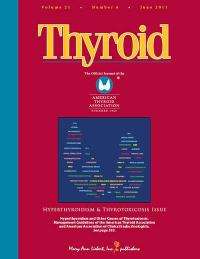New guidelines for diagnosis and management of hyperthyroid

New clinical guidelines developed by an expert panel that include 100 evidence-based recommendations for optimal care of patients with hyperthyroidism and other causes of thyrotoxicosis are presented in the current issue of Thyroid, a peer-reviewed journal published by Mary Ann Liebert, Inc.
Graves' disease (GD) is the most common form of thyrotoxicosis in North America and affects 1-2% of the population. Other causes of thyrotoxicosis, characterized by excessively high levels of thyroid hormone in the blood, include toxic multinodular goiter (TMG)—which is more common in Europe—autonomous thyroid nodular disease, and gestational thyrotoxicosis, which occurs during pregnancy.
A task force representing the ATA and AACE reviewed the medical literature and current standards of care and developed new guidelines that include recommendations for the following: initial evaluation and management of thyrotoxicosis; treatment of GD using radioactive iodine, antithyroid drugs, or surgery; management of GD in children, adolescents, and pregnant women; and subclinical hyperthyroidism. The lead author of the guidelines is Task Force Chair Rebecca Bahn, MD, Mayo Clinic, Rochester, MN.
"These guidelines combine the vast experience of the expert panel with the latest scientific literature and provide practical guidance for the clinician managing patients with hyperthyroidism," says Gregory A. Brent, MD, Professor of Medicine and Physiology, David Geffen School of Medicine at the University of California Los Angeles and President of the ATA.
A related Editorial in this issue of Thyroid by Elizabeth Pearce, MD, MSc (ATA Board of Directors and Boston University School of Medicine) and colleagues highlights the key features and shortcomings of the new guidelines, noting that they are more comprehensive and more modern in format—providing levels of evidence to support individual recommendations—than previous versions.
Geraldo Medeiros-Neto, MD (Executive Council, Latin American Thyroid Society and Senior Professor, University of São Paulo Medical School, Brazil), and coauthors of another Editorial accompanying the guidelines highlight recommendations developed and accepted equally by members of the task force from America and from Europe.
As the prevalence of thyrotoxicosis and its various forms and causes vary across the globe, as do preferred methods of therapy and patient management, this issue of Thyroid also includes an article by George Kahaly, MD, PhD (European Thyroid Association and Gutenberg University Medical Center, Mainz, Germany) and coauthors that presents a European perspective on the new guidelines, and Shunichi Yamashita, MD (Member of the council of the Asia & Oceania Thyroid Association, and Director, Atomic Bomb Disease Institute, Nagasaki University Graduate School of Biomedical Sciences, Japan), providing several expert viewpoints from Japan and Korea.
"Hyperthyroidism affects both genders and people of all ages. These state-of-the-art guidelines highlight treatments and practices that improve patient outcomes. Clinicians that follow these guidelines are likely to immediately improve the care of their patients," says Richard T. Kloos, MD, Professor, The Ohio State University and Secretary/Chief Operating Officer of the ATA.
More information: The guidelines, developed jointly by the American Thyroid Association (ATA) and American Association of Clinical Endocrinologists (AACE), are available free online at www.liebertpub.com/thy















